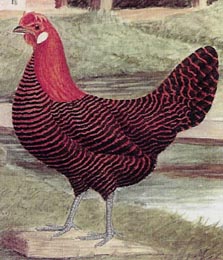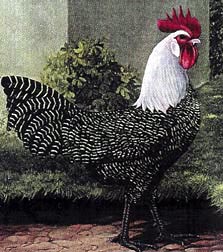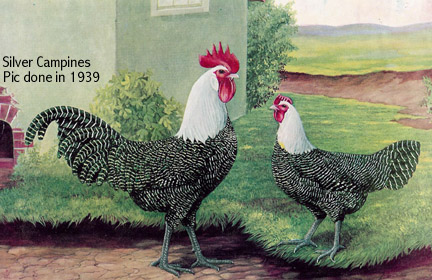|
THE CAMPINE - AUSTRALIAN STANDARDS MALE CHARACTERISTICS
CARRIAGE: - Alert and graceful
TYPE
Body broad, close and compact
Back rather long, narrowing to the tail.
Breast full and round
Wings large and neatly tucked
Tail carried fairly high and well spread
Campine males aree hen feathered, without sickles or pointed neck and saddle hackles.
The two top tail feathers slghtly curved.
HEAD
Moderately long, deep and inclined to width.
Beak rather short
Eyes prominent.
Comb single, upright, of mdium size, evenly serrated, the back well carried out and clear of the neck; free from excrescenses.
Face smooth
Ear-lobes inclined to almond shape, medium size, free from wrinkles.
Wattles fine and long.
NECK
Moderately long and well covered with hackle feathers. The formation of the neck feathers in the Campine is called the cape.
LEGS & FEET
Legs moderatley long
Shanks and feet free from feathers
Toes four, slender and well spread
FEMALE CHARACTERISTICS
With the exception of the single comb which falls gracefully over one side of the face, the general characteristics are similar to those of the male, allowing for the natural sexual differences.
COLOURS: The Gold Campine 
GOLD Male and Female Plumage:
Head and neck hackle: rich gold, not a washed out yellow. Remainder beetle green barring on rich gold ground colour. Every feather must be barred in a transverse direction with the end (or tip) of the feather, gold.
The bars to be clear with well defined edges, running across the feather. so as to form, as near as possible, rings around the body. Barring to be three times as wide as ground colour.
On the breast and underparts of the body should be straight or slightly curved; on the back, shoulders saddle and tail they may be of a V-shaped pattern, but preferably straight
The Silver Campine 
SILVER Male and Female Plumage:
Head and neck hackle: pure white. Remainder beetle green barring on pure white ground colour. The markings being identical to those of the Gold.
In Both Sexes and Both Varieties:
Beak ivory horn. Eyes dark brown with black pupil. Comb face and wattles bright red.
Ear-lobes white. Legs and feet leaden blue. Toenails ivory horn.
SERIOUS DEFECTS Sickle feathers or pointed hackles on the males. Bars and ground colour of equal width. Ground colour pencilled. Comb at the back too near to the neck Side sprigs or spikes on comb.
Legs other than leaden blue. White in face. Red eyes. Feather or down on shanks. Dark pigmentation in combs of females. White toe-nails. Slate blue beak. Black around the eye.
Note: the ideal is a bird clearly, distinctly and evenly barred all over with the sole exception of the neck hackle.
Taking the five main points of the bird -viz. Neck hackle, top (including back shoulders and saddle) tail, wings. and breast - each is of much importance as another.
Judges are requested to bear in mind that a speciman excelling in one or two particulars, but defective in others should stand no chance against one of the fair average merit throughout.
Special attention should be paid to size, type and fullness of the front in breeding and judging Campines.
Weights:
Male 2.50 - 2.95 kg
Female 2.00 - 2.50 kg
The Silver Campine - Why Rare in Australia?
By Bruce Pattinson

The Campine (pronounced Kampeen) is an outstanding and useful breed of fowl and it is difficult to understand why it has declined in popularity since the turn of the century. It is the purpose of this article to outline the general history and qualities of this breed to illustrate its potential, both to the backyard breeder and the poultry industry in Australia.
They are an ancient breed; the people of the Campine district say that when Julius Caesar left their country he took a number of these fowls back to Rome. Here epicures called them food for the Gods.
Campines are a light breed of fowl originating in Belgium and can have either silver or gold barring with the same coloured (but pattern-free) hackle. They are a friendly and attractive breed and have proven themselves in my yard to be excellent foragers. They are also fast maturing and feather up quickly. Early in the century the breed appears to have been quite common in Australia as an egg producer and the British Poultry Standards (1982) states it was famous for producing the finest winter milk chickens. Fred Hams, in Old Poultry Breeds (1994) writes that it fell from favour due to the small size of its eggs preventing it from being taken up by commercial producers.
I find the eggs to be a good size (around 60 grams) for a light breed and the birds are relatively prolific. Hadlington, in Poultry Farming in NSW (1923), includes the Campine in his list of light breeds suitable for farming, with weights set at 5lb. for cockerels and 4lb. for pullets. Even in 1930 we can find in the Poultry newspaper of September 9 ads for Campines which commend their size, type, vigour and egg production. Also mentioned is the famous Holmfield strain, but at this time I have been unable to trace this further.
Unfortunately, by 1943, Hadlington in his Australian Poultry Book had relegated the breed to his list of show birds only. It would be safe to assume its decline to the preference for the Leghorn at this time or the beginning of the surge of hybrids by commercial growers. The early popularity of the breed may have been related to the work at Cambridge University with autosexing when a gold bird was crossed with a Barred Plymouth Rock to produce the Cambar. There is no indication that this cross ever became popular in Australia but the Legbar is still bred. Even so Les Hill in Australian Bird Lover October 1958, states, The Campine is primarily a prolific layer all the year round and, as a table bird it is excellent in quality and the ratio of flesh is higher than in any other breed.
There seems to be no record of when the Campine first came to Australia but it is fortunate that fanciers kept the bird for the showbench. Unfortunately, to breed for show, the barring rather than the utility qualities are more important. This has led to a decline in the vigour of many of the birds I have seen. Luckily many birds, useless on the showbench, have the qualities that the backyarder wants. They do not go broody, look brilliant and produce well.
Not many Campines are seen on the showbench even now and they would certainly make a worthwhile project for anyone with an interest in rare breeds. I have found them to have good fertility and hatchability. Some problems however occur with the fast growth rate and feathering which can lead to feather picking. I have tried to solve this by using a high protein feed and supplying clumps of grass for them to pick at with some success. They do better in a pen on their own. Another feature of interest is that you can mate a gold and silver and get equal hatchings of both.
The overall qualities and special characteristics of the Campine should ensure its survival. I believe the breed has enough unique qualities to make it genetically significant to anyone with an interest in poultry. It is a rare breed but not because it is an uneconomical bird bur rather as a result of the whims of the post WW11 poultry industry.
Reprinted from ARMBA NEWS, Vol. 5. No. 5, Dec/Jan 1996/7
1997 Rare Breed of the Year

More Campine History will be added when I find time to upgrade the site
|  |


